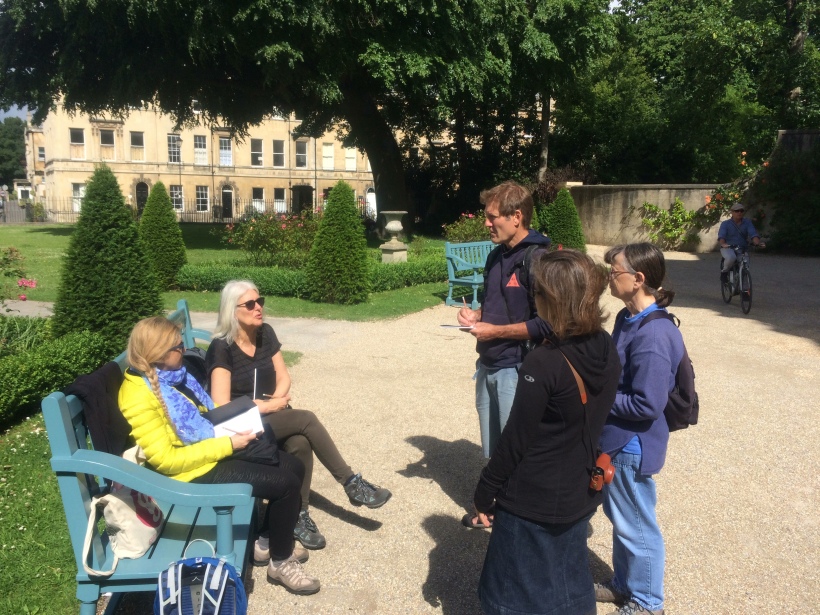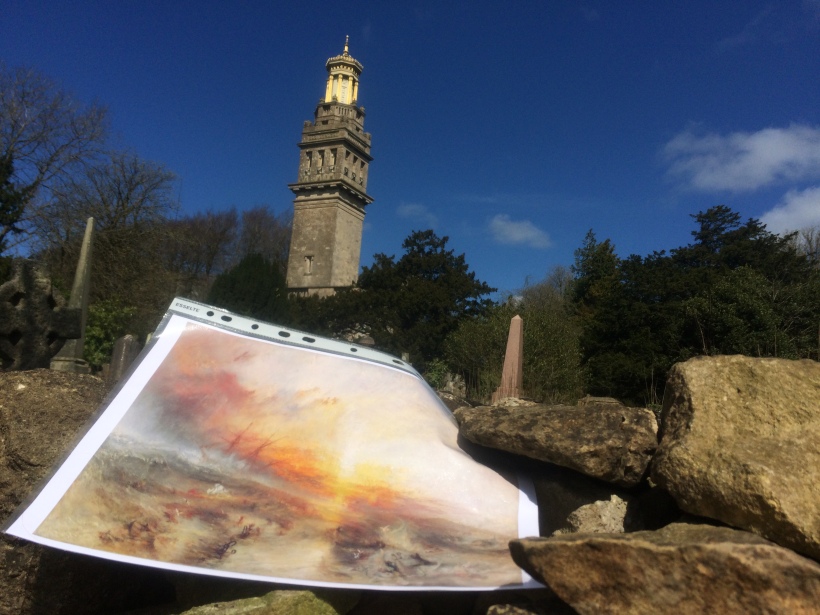A first stab at writing up my notes:
I come back from a walk a different person
Walk 1 From the Holburne Museum to Beckfords Tower
Bath’s Last Legal Slaveowners
2 proper tour guides on this first day walking team and I’m on stage edgey
One from the buses, the other from mad max.
and me.
Gathering in the sun outside the pillared temple of the museum at the top of Pulteney Street. Architectural icons from ancient slave economies fetished to represent learning and authority. The Roman Baths were discovered under the offices of Bath’s Poor Law Guardians. (archaeologicial irony)
Slaves ancient and modern, just like the poor of the City have no voice here.
Don’t mention the sugar.
Sugar that sweetened the tea and transformed chocolate to sweet treat.
Sweet ease of polite society hiding in glass cabineted silver bowls and tongs
No tongues for the sugar nips
Don’t mention the sugar, the Holburne doesnt
First thing in the high ceilinged morning cool gallery we talk in hushed tones. We drift toward Gainsborough’s portrait of slaveowners. One of the largest canvases he painted, it says. These were the people who came to the enchanted city to take the waters, to recover from the heat and disease, to network, to speculate, to gamble. The Byams, a family with its feet deep in the blood and flesh of the slave worked plantation economy. Gainsborough painted them. Pulteney financed accommodation for them, speculating with profits won from stolen land and stolen lives. The enchanted city flourished on their wealth and patronage

Out to the pleasure gardens to alert senses and sensibility.
Listen. Touch. Feel. Think.
Get the Jane Austen lived there, walked here, bit. Over.

And we walked too, stopping at the claimants addresses for:
A ritual reading of the ‘charge sheet’.
The address in Bath, where we stood;
The name of the slave-owner who lived there
Date of the court order;
Number of enslaved people;
Name of the plantation, parish, Caribbean island;
Number of pounds paid out in ‘compensation’ to the slave-owner
Those released received no compensation
I heard echoes of Linton Kwesi Johnson and the New Cross Fire
“13 dead and nothing said”
I try to break the silence of this enchanted city
A run of performative statements repetitive intentional becoming disturbing:
20 million paid out and nothing said
How many lives lost, how many lives never lived. How much life blighted.
Sweat in the water. Blood in the sea
Reading Dabydeen aloud and suggesting Turner’s hypocrisy
Slavers Throwing Overboard the Dead and Dying – Typhon coming on. 1840
The water cycle brings it all back to us now.
A Turner painting survives as the only record of Beckford’s monumental plantation-wealth funded Abbey
Did Beckford introduce Turner to a speculative money spinner, spun on lives and sugar?
Was he feeling guilty by 1840, decades after the Zong massacre?
In Bath no memorials only silent monuments to slave generated wealth:
Pulteney bridge
Guinea Lane
Beckfords tower.
We walk a city inscribed, the origins of its wealth obscured
Braikenridge collected watercolours of the rural South West,
just bought more with his compensation.
It was for others to create the plantation picturesque.
On Queens Square where Braikenridge claimed his share of the £20million there is no letter box for me to deliver his souvenir plaque. (architectural irony)

A conversation at a hotel on Pulteney street.
George Orwell’s grandparents claimed compensation from here.
The re-writing of history. (literary irony)
Outside the Park Street residence of Nathaniel Wells
First black JP and Lord Lieutenant of Monmouthshire. (no plaque)
Slaveowner. (no irony)
A conversation regarding family and loyalty.
The training of the white landed elite.
Power. Ruthlessness.
Hold a mirror to our modern European sensibilities and assumptions.
Raised as white elite, why would Wells have felt any more responsibility to his kin than to his class?
A conversation regarding performance…overkill? Repetitive?
Does a performative walk on such a theme need to be fun…does it need a distance?
What to do with the upset and anger.
Are we afraid of what we might unleash in ourselves?
Or had we just walked too far in the same direction?
Mad max suggests a making link to the Romans and get a laugh from lazy ‘locals’ enslaved to work at the baths.
It connects Horrible History style but denies.
I want to connect emotionally empathically. Taste the sweetness and think of human flesh digested by cowries in the ocean. Feel the rain and wonder about the memory of water. Hear the beat and dance to it.
The senses connect differently

At last bursting out to country
The finest view in England, so Beckford said.
Green treed river snaking through the valley
Watered with Atlantic rain.
Down there driven by water wheels
brass mills battered and thudded
Neptunes and Guinea pots
Brass manillas by the hundredweight
The currency of the slave trade
To go on the river to Bristol
For the slave ships across the sea to West Africa
To trade in human lives

On the grass at Beckford’s grave, the gilded tower behind us
Reading Dabydeen’s Turner and looking at Turner’s slave ship painting
A conversation on scuba diving in the Caribbean connects:
Heritage in the water.
Or as Derek Walcott put it far better than I
Where are your monuments, your battles, martyrs?
Where is your tribal memory? Sirs,
in that gray vault. The sea. The sea
has locked them up. The sea is History.
We conclude with the sweetness. Sugar cake.
Kendal Mint Cake for walkers, Wordsworth and sensory memory
Mindful of the cycle of water
Even if it the molecules don’t hold
We make memory at this place, at Beckfords grave.
We connect, bear witness, then climb the tower.
I came back from the walk a different person
(quoted The Sea Is History – Poem by Derek Walcott)

